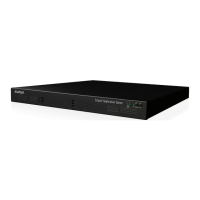We recommend choosing a rack without doors. If installing in an enclosed rack, ensure that
the rack has adequate ventilation.
2. Ensure that the environment is suitable and set up the rack, considering factors such as the
ambient temperature of the room. Read the safety instructions that came with your rack for
details.
Important:
Maintain a minimum clearance of 30 inches (76.2 cm) in the rear of the rack to allow
adequate airflow.
Ensure the rack is stable. The leveling jacks at the bottom of the rack should be fully
extended.
3. Decide where on the rack to place the device, using the guidelines listed below. Mark this
location on the rack, ensuring that the height is the same on each rack post.
Proper placement prevents the device from overheating and ensures that the rack is stable.
•
Find a space on the rack which is 3 empty square holes in height (1U), as shown in
Figure 2: One rack unit of space on the rack on page 10.
Note that the holes on the rack posts are not spaced equally. They form a repeating
pattern of two holes close together, then one hole separate, then two holes close
together and so on.
The top of the device should start on the lower of the two holes which are close
together.
Figure 2: One rack unit of space on the rack
•
If there are few devices mounted in the rack, find the lowest possible location to mount
the device, to ensure the rack remains stable.
4. Make sure you have the following items, which were shipped with the device and are used to
mount the rails to the rack (Figure 3: Preparing the parts required to mount the rails on page
11):
•
Two long outer rails and two short outer rails, to be attached to the rack itself (as
described in Mounting the Outer Rails on to the Rack on page 11)
Installation Guide for Avaya Scopia
®
Application Server Version 2 Setting up the Device | 10

